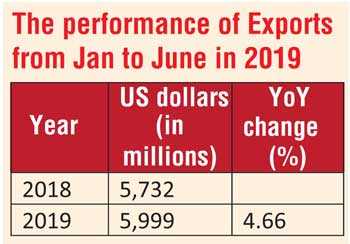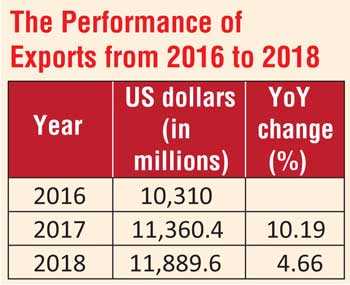Tuesday Apr 22, 2025
Tuesday Apr 22, 2025
Monday, 30 September 2019 00:00 - - {{hitsCtrl.values.hits}}
By Ashoka Mihindu
The propagandists of Gotabaya are trying their level best to convey that this Government has not done anything for the economy. However, such assertions are nothing but a complete distortion of the truth.
Developing the correct strategy
The previous Rajapaksa regime’s mantra for economic development was heavily reliant on developing infrastructure, financed by commercial loans from the EXIM Bank of China. Such a debt-driven model of economic development is not something which can be sustained in the long term. In fact, some of the landmark projects of the previous government such as Mattala Airport and the Mahinda Rajapaksa International Convention Centre have become huge white elephants. The Lotus Tower is the latest addition to this list.
This Government realised that the path of making Sri Lanka a rich nation is to integrate with the global marketplace by vigorously promoting exports and FDIs. This strategy has a lot of merit, as we are a country with a relatively small domestic market which does not have a high purchasing capacity. That is how countries like Singapore and South Korea became prosperous nations. 
Regaining the EU GSP+ concession
As soon as this Government came in, Prime Minister Wickremesinghe and the current Minister of Economic Reforms, Dr. Harsha de Silva took painstaking efforts to regain the GSP+ facility, which was lost due to the isolationist foreign policy of the Rajapaksa era. Fortunately, Sri Lanka was readmitted to the GSP+ in May 2017 by the EU. Although exports declined in 2015 and 2016, the trend reversed in 2017 and 2018.
“Since the reinstatement of the EU GSP+ scheme in May 2017, exports to the EU grew notably through this scheme, benefitting from the removal of duties for 66% of total tariff lines. Garments, rubber products, tea, food and beverages and tobacco, and seafood were the main export categories under the EU GSP+” – Pg. no. 146 of the 2018 Central Bank Annual Report.
In 2018, Sri Lanka achieved an export income of $ 8,374 million from service exports in comparison to $ 7,724 million in 2017. Furthermore, seafood exports that were adversely affected due to the suspension imposed by the EU, have recovered since the lifting of the ban. They have grown considerably over the last two and half years, to reach $ 265.8 million in 2018 from only $ 169.6 million in 2016.
National Export Strategy (NES)
The Sri Lanka Export Development Board (EDB), with the technical assistance from the International Trade Centre (ITC), developed a comprehensive NES, which aims to increase Sri Lanka’s export income from both goods and services to $ 27 billion by 2022, that was approved by the Cabinet in 2018. This was indeed a praiseworthy initiative, as it aims to transform the country to a supplier of high-value products and services to the world market by diversifying Sri Lanka’s existing, narrow export basket – which is dominated by apparel and tea – and export destinations.
The EDB has rightfully identified six focus sectors to be promoted under this programme, namely: spices and concentrates, electrical and electronic components, boat building, wellness tourism, food and beverages, and ICT/BPM sector. 
Market Access Support Programme
As part of the 2018 Budget, the Government allocated funds to initiate a Market Access Support Programme through the EDB to help entrepreneurs to expand markets, modernise/upgrade products/services and production processes and increase market access to connect and compete by introducing improved value-added products and services. Numerous enterprises representing rubber, footwear, coconut, machinery parts and components, food packaging, ornamental fish and jewellery have been provided matching grants under this scheme via the coordination of the EDB.
An export-friendly, exchange-rate regime
The present exchange-rate policy practiced by the Central Bank has been extremely helpful to the exporter community of Sri Lanka. As pointed out by The Daily FT columnist, W.A. Wijewardena, during the Rajapaksa administration – from 2011/12 – the Central Bank spent $ 4.2 billion out of its reserves to defend the rupee, thus, harming the competitiveness of Sri Lanka’s exports. Thankfully, that ill-advised practice has now been abandoned, and the exporters must be grateful to the current Central Bank regime for that.
Connecting with the world
To illustrate the isolationism and backwardness of the previous Rajapaksa regime, not a single bilateral Free Trade Agreement (FTA) was signed from 2005 to 2014. Countries such as Vietnam and Singapore have signed FTAs with a number of countries and economic blocks to accelerate the growth of their exports (Vietnam has 26 FTAs and Singapore has 43 FTAs). A FTA with Singapore was signed last year while discussions are now underway to sign FTAs with China, Bangladesh, Malaysia, South Korea, and Thailand. Many prominent politicians in the opposition who are now backing Gotabaya such as Bandula Gunawardena and Wimal Weerawansa vehemently opposed the FTA with Singapore. Can we expect any FTAs under a Gotabaya presidency?
The need for a pro-business, liberal government
The renaissance that was witnessed in exports over the last two and half years can only be maintained if we elect a political leadership which is backed by a movement that is composed of forces who have a demonstrated capacity in managing foreign relations successfully in addition to having a cosmopolitan, internationalist outlook.
Can we expect this from Gotabaya, as he is championed by groups that are opposed to free trade, competition, and the freedom of choice? Definitely no! In contrast, as explained by me from my last week’s article, Gotabaya and his fan club are lovers of Donald Trump who espouses isolationism and import substitution – a combination which is extremely harmful to a country like us.
Discover Kapruka, the leading online shopping platform in Sri Lanka, where you can conveniently send Gifts and Flowers to your loved ones for any event including Valentine ’s Day. Explore a wide range of popular Shopping Categories on Kapruka, including Toys, Groceries, Electronics, Birthday Cakes, Fruits, Chocolates, Flower Bouquets, Clothing, Watches, Lingerie, Gift Sets and Jewellery. Also if you’re interested in selling with Kapruka, Partner Central by Kapruka is the best solution to start with. Moreover, through Kapruka Global Shop, you can also enjoy the convenience of purchasing products from renowned platforms like Amazon and eBay and have them delivered to Sri Lanka.
Discover Kapruka, the leading online shopping platform in Sri Lanka, where you can conveniently send Gifts and Flowers to your loved ones for any event including Valentine ’s Day. Explore a wide range of popular Shopping Categories on Kapruka, including Toys, Groceries, Electronics, Birthday Cakes, Fruits, Chocolates, Flower Bouquets, Clothing, Watches, Lingerie, Gift Sets and Jewellery. Also if you’re interested in selling with Kapruka, Partner Central by Kapruka is the best solution to start with. Moreover, through Kapruka Global Shop, you can also enjoy the convenience of purchasing products from renowned platforms like Amazon and eBay and have them delivered to Sri Lanka.